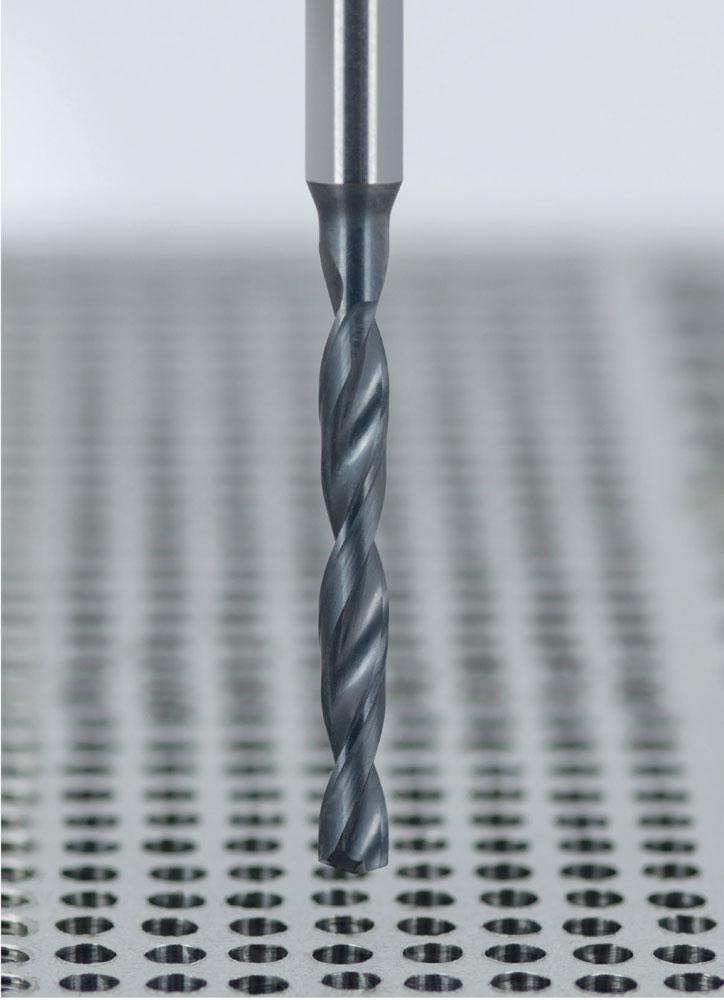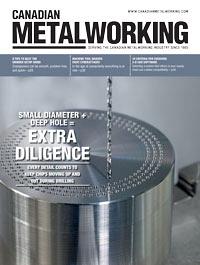- FMA
- The Fabricator
- FABTECH
- Canadian Metalworking
Small Diameter + Deep Hole = Extra Diligence
Every detail counts to keep chips moving up and out during drilling
- By Sue Roberts
- March 16, 2017
- Article
- Metalworking

A hard coating protects the tip of a small-diameter, deep-hole drill while polished flutes help with chip removal. Photo courtesy of Walter USA.
Depth-to-diameter is the ratio that will dub a drilling project as deep hole. The comparative values in this quantifying relationship that assign this label start at 5-to-1 and extend to 30-to-1 and beyond. Drilling holes that fall within these parameters comes with its own set of issues. Shrink the diameter of the hole to 3 mm or less and the task can become even trickier. Extra attention to process details is needed to help these long, thin drills do their jobs.
Controlling runout, choosing proper drill configurations and finishes, managing chip size and removal, and checking coolant filtration--important aspects any efficient drilling process—are critical to the efficient production of quality, small-diameter, deep holes.
“Runout is the first concern,” said Sam Matsumoto, application engineer at OSG Canada. “If you have runout problems, you are not going to get good-looking, proper-sized holes. Runout issues will most likely give you oversized holes.”
Using a heat shrink toolholder, he said, will help keep the tool rigidly aligned with the main axis and reduce vibrations that prematurely wear out the tooling. “The heat shrink process takes an investment, but it eliminates the potential of moving parts in the toolholder/drill assembly.”
TOOLS NEED “BALANCE”
Tools for drilling small-diameter, deep holes are, by necessity, thin and long. They need to possess a balance of strength, which equates to a drill diameter that is as thick as possible, and flutes with a rake or helix angle generous enough to keep the chips moving out as the slender hole is created. Matsumoto described it as the “sweet spot,” where the chip pockets are large enough to evacuate the chips but the drill maintains its rigidity.
Helmut Strobel, product manager for drilling at Emuge, said that deep-hole drills are most effective when the drill web thickness is reduced, allowing for increased flute space for chip evacuation. “Microdrills, and in particular carbide microdrills, require heavier web thickness percentages than larger-diameter drills due to the fragility of the small tool. The size of the tooling also limits the point geometry and web thinning options. Faceted point grinds are the most common because they provide added cutting stability.”
Drills for the small-diameter, deep holes that have cutting geometries and clearances that fall within the neutral range are designed to machine a variety of materials. They can move from a stainless job to a steel job to an aluminum job. Drills designed for specific materials have geometries intended to work more efficiently and reduce potential issues that can arise because of the material characteristics. They are most commonly used in high-production environments.
Luke Pollock, product manager at Walter USA, said, “An example of a special is a drill designed for making deep, narrow holes in cast iron. It is going to have a negative geometry, which gives it a very strong cutting edge that resists abrasive wear, but it won’t have good chip control. The lack of chip control is OK in cast iron because the material will crumble off and create small, flaky chips that are not difficult to evacuate. A drill for stainless may be totally the opposite, with a positive geometry and sharp tip to create a high shear force. That will cut the material cleanly without generating much heat and control the long, stringy chips that result when cutting stainless.
“I think that choosing between a universal and special drill is a business decision. It depends on what you want to accomplish—economy of time, reduction of tooling costs, or tooling flexibility. If a part is produced in a large quantity, a special drill can be worth the investment. It will last longer. A universal drill can be appropriate for a job shop environment that deals with drilling small quantities of holes in a variety of materials,” Pollock said.
PECKING SHOULD BE AVOIDED
Pecking, a technique that backs up and pauses the drill to allow extra time for chip removal before it continues with the cutting process, should be avoided when using solid-carbide drills. “The reason to start a peck cycle would be if chips are being created faster than they can be evacuated. This can be a good strategy if you are dealing with high-speed steel drills, but if you are using solid-carbide drills, it will seriously hurt the life of the drill,” said Pollock.

Deep-hole drills are most effective when the drill web thickness is reduced, allowing for increased flute space for chip evacuation. Photo courtesy of Emuge Corp.
Matsumoto said, “With pecking you get more time to evacuate the chips through the narrow passage, but think of it as using the drill like a hammer. Even if you are cautious so that the drill doesn’t break from the repeated impact, you sacrifice tool life.”
FLUTES, COOLANT WORK TOGETHER
Highly polished or coated flutes and coolant-through tools combine to send chips slipping and sliding out of deep, narrow holes.
Strobel said that manufacturers of high-performance microdrills addressed the chip issue by incorporating internal coolant holes and parallel web construction. High-pressure coolant is introduced at the cutting zone and this helps eject chips from the flutes. “Specialized carbide coolant blanks paired with precision CNC grinding equipment allow manufacturers to produce micro-coolant-fed drills down to 0.075 mm diameter,” he said.
Matsumoto said, “In general, you want to produce small chips and be sure you have effective evacuation. If you don’t get the chips out, they will accumulate in the flutes and you get chip packing. It’s a domino effect. One gets caught and blocks the exit of the one behind it and so forth. A smooth surface is a good advantage, and coolant-through is good for these projects.”
Coolant pressure between 300 and 600 PSI is recommended for keeping the narrow, deep cuts clear, but Pollock cautioned about using pressure that is too high. “You probably want to be in the 500- to 600-PSI range. If the pressure is too high, the coolant will try to push the chips out of the hole faster than the auger action of the drill. The coolant might force the chips out so fast that they can’t flow around the drill body.”
Keeping the coolant clean is also critical. Strobel said that filtration must be adjusted and monitored to prevent suspended chips in the coolant supply from clogging internal coolant holes. He recommends coolant pressure between 300 and 600 PSI and using a 5 µm or finer coolant filter.
Matsumoto said, “I had a situation where the machines were good, the tooling was good, the holders were good, but their tools were wearing out prematurely. It turned out they weren’t properly filtering their coolant. You could feel the metal particles in it. It was like drilling with sand.“You have to pay attention to the smallest detail or it will become a big problem for producing small-diameter, deep holes.”
Emuge Corp., 800-323-3013, www.emuge.com
OSG Canada Ltd., 800-263-4861, www.osgtool.com
Walter USA, 800-945-5554, www.walter-tools.com
About the Author

Sue Roberts
2135 Point Blvd
Elgin, IL 60123
815-227-8241
Sue Roberts, associate editor, contributes to both Canadian Metalworking and Canadian Fabricating & Welding. A metalworking industry veteran, she has contributed to marketing communications efforts and written B2B articles for the metal forming and fabricating, agriculture, food, financial, and regional tourism industries.
Roberts is a Northern Illinois University journalism graduate.
subscribe now


Keep up to date with the latest news, events, and technology for all things metal from our pair of monthly magazines written specifically for Canadian manufacturers!
Start Your Free Subscription- Industry Events
MME Winnipeg
- April 30, 2024
- Winnipeg, ON Canada
CTMA Economic Uncertainty: Helping You Navigate Windsor Seminar
- April 30, 2024
- Windsor, ON Canada
CTMA Economic Uncertainty: Helping You Navigate Kitchener Seminar
- May 2, 2024
- Kitchener, ON Canada
Automate 2024
- May 6 - 9, 2024
- Chicago, IL
ANCA Open House
- May 7 - 8, 2024
- Wixom, MI





















